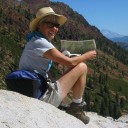A mecca for climbers—and anyone who loves mountains
We are back in Parque Nacional Los Glaciares (Glacier National Park), this time in the sturdy little town of El Chaltén, located right at the edge of the park. It consists of lodging, restaurants, excursion companies—everything geared to the people who come here from all over the world to climb and hike during the summer season. Here is a photo...
Tectonic plates at the end of the world
As we have headed south, we have gotten closer to active plate boundaries - closer to the convergent plate boundary (subduction zone) along the western coast of Chile and closer to Argentina's only plate boundary - the transform boundary between the South American plate and the Scotia plate. Below is a map of the plates in this region. You may...
Ushuaia – el fin del mundo (the end of the world)
Ushuaia is the southernmost city in the world, at 50 degrees south latitude. True, there is the small town of Puerto Williams that is slightly more south, on the south shore of the Beagle Channel, and there is a small scientific settlement (McMurdo Station) in Antarctica, but Ushuaia is a bustling city of about 70,000 people that takes full advantage...
When glaciers dominated this landscape
The photo below is from Cerro Cristales, looking northeast across the valley now occupied by Lago Argentina (lake in the distance) and its narrow western arms (lakes in the foreground). Twenty thousand years ago this valley was filled with glaciers. El Calafate, the popular tourist town that sits on the south shore of Lago Argentina, and that is the base...
The glacier that marches to its own drummer
As you are probably aware, most of the glaciers in the world are retreating (getting smaller). For example, in Glacier National Park in Montana, the glaciers are expected to be completely gone in the next decade or two. In Argentina's glacier park (Parque Nacional Los Glaciares), most glaciers are also retreating. But not the Perito Moreno glacier. It steadfastly continues...
On the road
Having spent 8 hours today traveling from Puerto Santa Cruz on the Atlantic coast to El Calafate on the edge of the Andes, it seems a fitting time to evoke Jack Kerouac's book (On the Road) and reflect on traveling options. The sites in Patagonia are spectacular but the distances between them are large. How best to travel between them?...
Darwin marveled at the terraces and gravel, and so do we
We are now at 50 degrees latitude, at the lovely little town of Puerto Santa Cruz, located on the south bank of Rio Santa Cruz not far west of where it empties into the Atlantic Ocean. In 1834, during his voyage on the Beagle, Darwin entered this river and traveled up it until he could see the cordillera (the Andes)....
The flood with unexpected consequences (it fossilized plants!)
West of Comodoro Rivadavia, a prosperous but mostly unattractive town devoted to the petroleum business, is the village of Sarmiento. Most of Patagonia is a desert with low-growing bushes and long vistas. Between C. Rivadavia and Sarmiento, one is reminded of Texas, with oil wells (here referred to as penguinos - penguins!) on a relatively featureless landscape (affectionately referred to...
Our favorite critters and don’t forget that plants make fossils too
Almost a million penguins - even a geologist has to be impressed by the quantity, not to mention the silly antics, of these crazy flightless birds. We went to Punta Tombo where at least 250,000 mating pairs have made burrows in the sediment - they return each year to give birth and raise their young (called pichons) before they all...
Some of the critters went extinct (fossils!)
This province (Provincia Chubut) is super rich in life forms. But even more diverse than the organisms living today are those that have gone extinct. From east (near the coast) to west (near the Andes), sedimentary deposits are progressively older and have fossils from the Cenozoic (age of mammals), Mesozoic (age of reptiles, including dinosaurs), and Paleozoic (old life, including...
Critterlandia
Peninsula Valdéz is at 42 degrees (Buenos Aires is at 34 degrees) so the days are longer - it's not dark until about 9). For those of you who know the Point Reyes Peninsula, where I've done geologic research, there are some surprising similarities. A narrow strip of land extends seaward and ends at coastal cliffs that are uplifted marine...
Nature in Buenos Aires?
Buenos Aires located on southwest shore of Rio de la Plata estuary, the boundary between Argentina and Uruguay. To get to Patagonia, it's first necessary to go through Buenos Aires, a large bustling city where more than 1/3 of the country's 40 million people live. To get to Buenos Aires, we passed through Washington, D.C., now...
- « Previous
- 1
- 2
- 3
- Next »
About the Blogger
 Karen (here with Mt. Shasta in background) is a geology professor emerita who aims to provide a "pocket geologist" for world travelers. Follow the blog to explore the landscapes of our planet and figure out what causes them to look the way they do.
Karen (here with Mt. Shasta in background) is a geology professor emerita who aims to provide a "pocket geologist" for world travelers. Follow the blog to explore the landscapes of our planet and figure out what causes them to look the way they do.













